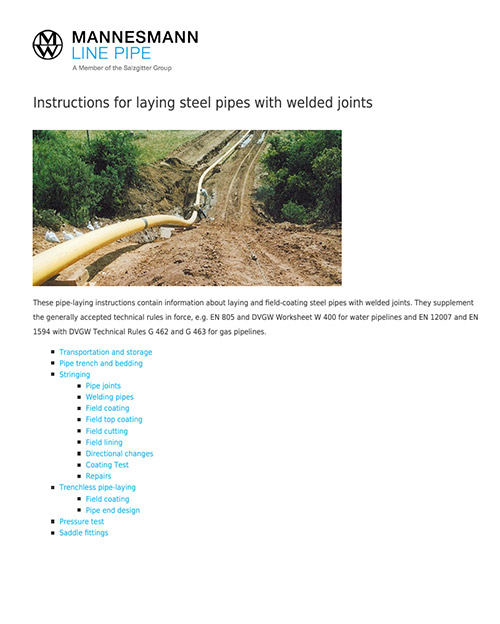Pressure test
The pressure test must be carried out in compliance with the requirements laid down in the relevant rules and regulations, e.g. for gas pipelines the DVGW Worksheet G 469 and/or the VdTÜV Data Sheet 1060 and for gas pipelines up to 16 bar, EN 12327.
The example set out below illustrates the pressure test for water pipelines in compliance with EN 805 and/or DVGW Worksheet W 400-2.
Each pipeline must be subjected to a pressure test after it has been laid. Pressure tests must be carried out by qualified personnel with the relevant knowledge of pipeline engineering, the execution of pressure tests, the measurement techniques and the applicable safety regulations.
Before the pressure test can be carried out, the pipeline must be covered with backfill material so as to avoid shifts in position, which could cause leaks. This applies in particular to pipelines with mechanical socket connections. The joints need not be covered by backfill. The pipeline is to be tested over its entire length or, if necessary, in sections. The test sections must be defined so that:
- the test pressure is reached at the deepest point of each test section
- and a pressure of at least 1.1 times the maximum design pressure (MDP) is reached at the highest point.
The system test pressure (STP) can be calculated on the basis of the MDP as follows:
- with calculation of the pressure surge: STP = MDP + 1 bar
- without calculation of the pressure surge, STP = MDP x 1.5, or STP = MDP + 5 bar (the lower value applies).
Before starting the test, the pipeline must be slowly and evenly filled with water at a rate of about 0.3 l/s (DN 100) to 6 l/s (DN 400) and the air must then be evacuated.
The pressure test is carried out in a maximum of three steps.
- Preliminary test: To stabilize the pipeline section when the soil has finally settled and the cement-mortar lining has absorbed sufficient water. Water absorption in the cement-mortar pores may initially cause a drop in pressure even if the pipeline is completely watertight. For this reason it is advisable to carry out the pressure test over a period of at least 24 hours. The pressure must be brought back to the test level at regular intervals and in any case after a drop of 0.5 bar.
- Pressure drop test: Determines the amount of air still in the pipeline. Carry out as specified by the planner
- Main test: There are two basic test methods: the pressure loss method and the water loss method.
The main test is a test of the entire system, and in particular of the watertightness and proper execution and installation of the pipes, fittings, etc. It is carried out over a period of 3 hours (for pipes up to DN 400). The pressure loss may amount to:
- 0.1 bar at a system test pressure (STP) of 15 bar (MDP: 10 bar)
- 0.15 bar at a system test pressure (STP) of 21 bar (MDP: 16 bar), and
- 0.2 bar at a system test pressure (STP) of MDP+ 5 bar (MDP: >16 bar)
The water loss method (see DVGW Worksheet W 400-2) can be used as an equivalent alternative to the pressure loss method described above.
